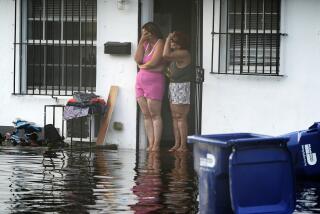Inundated With Business : Storm Damage to Vehicles Keeps Car Rental Firms, Body Shops Busy
Thousands of Southern Californians, again soggy and unhappy as a new storm approached Friday, have something other than soaked carpets to worry about: all those broken down and banged-up cars, damaged as a result of poor driving conditions on streets and highways.
Drivers face longer waits for a repaired set of wheels because insurance companies are bogged down with large numbers of claims and body shops are bogged down with huge numbers of cars--as well as the dilemma of trying to work in the rain. And in the meantime, trying to find a rental car is harder than ever.
In the rental car business, âone manâs pain is another manâs gain,â said Mitch Rubinoff, chief financial officer at the Thrifty car rental corporate office in Simi Valley. Business is up about 20% over this time last year because of the rash of rain-related accidents, he said.
âWe have a fleet of 600 cars, and theyâre all out,â he said. âAs soon as they come in, they go right back out.
âBut some of our cars have also been in some of those fender-benders because of the rain, and we canât fix them fast enough,â he said.
At Enterprise Rent A Car in the Mid-Wilshire area, which specializes in local and neighborhood rentals as opposed to tourist business, Tony Hwang said the company is renting about 200 cars a day, up 30 from the usual number.
âWe are really tight on cars,â Hwang said. âWe are even having a hard time getting cars from other offices.â
*
Ira Robb, Enterpriseâs executive vice president for Southern California, said: âI havenât seen a demand like this for rental cars since the rains we had in 1983.â
The storm left hundreds of cars waterlogged on the roads and in underground parking garages. In addition, during the heaviest days of rain a total of about 4,000 vehicle-related accidents were reported, according to California Highway Patrol spokesman Tito Gomez. Gomez said that was nearly three times the usual total.
Most of the collisions during the rains were because of cars hydroplaning and skidding, especially when drivers had to come to quick stops and often failed to judge proper following distance.
âWe are repairing about 50% more cars than we usually do. We got a lot of calls on the stormsâ worst days,â said Hector Morales, who owns Rainbow Auto Body Shop in Hawthorne, and has cars backed up to the street.
(BEGIN TEXT OF INFOBOX / INFOGRAPHIC)
BEHIND THE WHEEL The rains have posed a major challenge for Southland drivers, who have faced flooded roads and other dangerous conditions. Experts offer the following tips for driving in the rain:
DRIVING TIPS * Wet roads: In heavy rain, tires lose contact with the road at about 50 m.p.h. The car will begin riding on water or âhydro-planing.â If you start to hydroplane, slow down gradually--donât apply the brakes. * High water: To avoid dangerous skids, enter flooded areas slowly. Also, tires hitting puddles at high speed kick water up into the electrical system and the air intake, triggering stalls. * The 4-second rule: Use a four-second rule on wet pavement. When the vehicle ahead passes a certain point, such as a sign, count âone thousand, two thousand, three thousand, four thousand.â If you pass the same point before four thousand, you are following too closely. Another rule of thumb: Stay far enough back on freeways to see light beneath the car in front of you. * Wet brakes: Dry them by pressing the gas and brake pedals at the same time so that the car drives against the pressure of the brakes. Do this ONLY until brakes begin working. * If you skid: Braking too hard or turning too sharply can cause skidding. To recover: 1. Release brake to unlock wheels 2. Straighten the front wheels and turn in the direction you want to go 3. Gradually slow vehicle until you are sure you are in control * Space cushion: To avoid skids, keep enough space on all sides of the car, to brake or maneuver as needed. * Blind spots: Donât drive in another driverâs blind spot. Speed up or slow down so other drivers can spot you in rear view mirrors
FLOODED CARS
Experts warn that starting a car that has been in two or more feet of water can cause severe damage. Their advice: have it towed to a qualified mechanic to assess damage and perform a solid electrical checkup.
A CHECKLIST * Check engine oil for signs of water * Pull spark plugs to see if water is inside engine (once spark plugs are pulled, mechanic can crank engine) * Check transmission fluid for signs of water * Check differential fluid for signs of water * Check distributor and rotor for wetness * Check for moisture in alternator. (Alternator can short out if wet) * Dry out carpet and seats as soon as possible to prevent mold from forming. (A wet/dry vacuum can help dry out interiors) * Make sure vent at bottom of door is clear so water can drain. Also clear debris from water channels at front of hood
Sources: Jeffrey Spring, AAA; Department of Motor Vehicles
More to Read
Sign up for Essential California
The most important California stories and recommendations in your inbox every morning.
You may occasionally receive promotional content from the Los Angeles Times.









